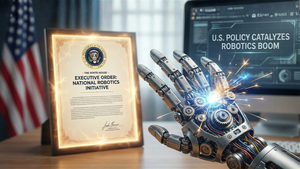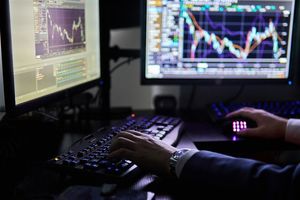
The relentless excitement surrounding Artificial Intelligence (AI) has emerged as the primary catalyst propelling the stock market to unprecedented levels, profoundly influencing the S&P 500's performance as of October 29, 2025. This "AI Gold Rush" has not only seen the S&P 500 achieve its 36th record close of the year but has also delivered an impressive 18.33% return over the past year, building on stellar gains from 2023 and 2024. The sustained rally has cultivated a distinctly bullish sentiment, attracting substantial capital inflows and recalibrating investor expectations for future growth.
This surge is largely concentrated within the technology sector, with the "Magnificent Seven" tech giants—Apple (NASDAQ: AAPL), Amazon (NASDAQ: AMZN), Alphabet (NASDAQ: GOOGL), Meta (NASDAQ: META), Microsoft (NASDAQ: MSFT), Nvidia (NASDAQ: NVDA), and Tesla (NASDAQ: TSLA)—acting as the principal engines. These companies, which now account for nearly 37% of the S&P 500's total market capitalization, have consistently outperformed the broader index, demonstrating the profound impact of AI integration and innovation on their valuations. However, this concentrated growth also raises questions about market breadth and potential overvaluation, as the S&P 500's forward 12-month P/E ratio climbs higher than historical averages.
The Unfolding Narrative: AI's Grip on Market Dynamics
The current AI-driven market surge is a culmination of several pivotal developments that began to accelerate in late 2022 and throughout 2023. The widespread adoption and capabilities of generative AI models, exemplified by OpenAI's ChatGPT, ignited a fervor that quickly permeated the technology sector and beyond. This initial spark transformed into a full-blown market trend in 2024, as major tech companies began aggressively investing in AI research, development, and infrastructure. By early 2025, the narrative shifted from speculative interest to tangible strategic imperatives, with nearly every major corporation outlining AI integration plans.
A key turning point arrived in the first half of 2025, as a series of strong earnings reports from AI-centric companies, particularly those involved in chip manufacturing and cloud computing, validated the immense capital expenditures being poured into the sector. Nvidia (NASDAQ: NVDA), for instance, has been a central figure in this narrative. The company, which briefly achieved a historic $5 trillion market capitalization on October 28, 2025, has seen its stock surge nearly 5% on that day alone, driven by robust demand for its high-performance AI chips. Its Q1 FY2026 revenue highlighted that over 40% of its earnings were directly attributable to its AI data center products, underscoring its pivotal role in building the foundational infrastructure for the AI revolution.
Other tech titans have also played significant roles. Microsoft (NASDAQ: MSFT) has aggressively integrated AI across its product suite, from Azure cloud services to its Office applications, with its Azure platform alone generating over $42 billion in Q3 2025 from AI-driven services. Apple (NASDAQ: AAPL) briefly surpassed a $4 trillion market value, signaling its deepening commitment to AI advancements within its ecosystem. The collective performance of these "Magnificent Seven" companies has propelled the Information Technology sector to year-to-date gains exceeding 20% in 2025, cementing its position as the undisputed market leader. Investors are now keenly watching Q3 and Q4 2025 earnings reports, released this week, to gauge if these substantial AI investments are translating into sustained revenue growth and profitability, which continue to fuel investor confidence in the AI narrative.
The AI Divide: Winners Emerge, Others Face Disruption
The pervasive influence of the AI frenzy has created a distinct divide in the market, carving out clear winners and posing significant challenges for those unable to adapt. At the forefront of this revolution are the semiconductor manufacturers, who serve as the foundational enablers of AI. Nvidia (NASDAQ: NVDA) remains the quintessential example, having achieved a historic $5 trillion market capitalization and experiencing soaring demand for its advanced Graphics Processing Units (GPUs), which are indispensable for deep learning and neural network training. Its strategic investments, including a $100 billion stake in OpenAI, and collaborations with companies like Uber (NYSE: UBER) and Nokia (NYSE: NOK) for autonomous vehicles and 6G technology, further solidify its dominant position. Similarly, Advanced Micro Devices (NASDAQ: AMD) has seen its fortunes rise, bolstered by significant chip deals with OpenAI and IBM (NYSE: IBM), positioning it as a critical diversified supplier of AI chips. Companies like Broadcom (NASDAQ: AVGO), Marvell Technology (NASDAQ: MRVL), and the crucial Taiwan Semiconductor Manufacturing Company (NYSE: TSM) are also thriving as essential components suppliers in this rapidly expanding ecosystem.
Beyond hardware, cloud computing providers are reaping immense benefits by offering the scalable infrastructure and specialized AI services necessary for businesses to develop and deploy AI applications. Microsoft (NASDAQ: MSFT) with its Azure platform, Amazon (NASDAQ: AMZN) through Amazon Web Services (AWS), and Alphabet (NASDAQ: GOOGL) with Google Cloud, are all experiencing substantial growth in AI-related demand. These platforms provide everything from purpose-built AI infrastructure and GPUs to advanced APIs and Large Language Models (LLMs) like Gemini, making AI accessible to a vast array of enterprises. Software companies like Salesforce (NYSE: CRM), which is aggressively integrating generative AI across its offerings to boost Annual Recurring Revenue (ARR), and Palantir Technologies (NYSE: PLTR), whose Artificial Intelligence Platform (AIP) simplifies AI integration for businesses, are also poised for significant gains by developing the tools that make AI functional and impactful.
Conversely, companies slow to integrate AI or burdened by legacy systems face the risk of obsolescence and market share erosion. Traditional businesses heavily reliant on manual labor or repetitive tasks, such as certain administrative support roles or customer service centers without AI integration, will struggle to compete on cost and efficiency against AI-augmented rivals. Furthermore, industries susceptible to disintermediation, like traditional financial brokers without AI-powered robo-advisors, or content creation agencies that fail to leverage AI for generation and optimization, face disruption from more agile, AI-first competitors. The market is also wary of nascent AI companies with high valuations but limited revenue, raising concerns about a potential "AI bubble" if promised returns fail to materialize, leading to potential valuation corrections for those built on hype rather than tangible results. The imperative for survival and growth now mandates a proactive embrace of AI, transforming operations, customer experiences, and strategic decision-making across all sectors.
A New Industrial Revolution: Broad Implications and Lingering Questions
The AI frenzy transcends mere stock market performance, signaling a profound shift akin to a new industrial revolution with far-reaching implications across global industries and economies. The "AI trade" has become the dominant force driving market rallies, pushing major indices to new highs and establishing AI integration as a fundamental business strategy across sectors from healthcare and finance to manufacturing and energy. This pervasive adoption is fueling unprecedented capital expenditures in AI infrastructure, with tech giants collectively investing hundreds of billions, and the emergence of "Sovereign AI" initiatives where nations prioritize domestic AI capabilities, further driving a multi-trillion-dollar investment cycle. The booming demand for AI data centers, in turn, is creating ripple effects in commodity markets, increasing demand for power and raw materials like copper and uranium.
The ripple effects of this transformation are reshaping industries and labor markets. AI's ability to automate, analyze, and innovate is compelling companies to rapidly adopt AI strategies or face obsolescence, fostering new innovation ecosystems through partnerships between AI developers and traditional industries. While some early 2025 estimates projected significant job displacement, more recent analyses suggest a nuanced and slower adoption, with new job opportunities potentially emerging to offset losses. However, disruption is already evident in specific tech-exposed occupations, with jobs involving repetitive tasks being prime targets for automation. Economically, AI is expected to significantly boost labor productivity, with Goldman Sachs (NYSE: GS) Research estimating a 15% increase in developed markets upon full adoption, and McKinsey projecting $13 trillion in additional global economic activity by 2030, though direct evidence of this productivity surge in broader economic data remains elusive.
Regulatory bodies worldwide are grappling with the rapid advancement of AI, bringing ethical concerns and accountability to the forefront. The "black box" nature of advanced AI models, alongside issues of bias and data privacy, is prompting increased scrutiny and a demand for greater transparency. Board-level oversight of AI has intensified, with a growing focus on robust disclosure around AI ethics and guardrails. The rise of "agentic AI" systems, capable of autonomous planning, presents unprecedented governance challenges, especially in highly regulated sectors and retail investing, where market manipulation risks are amplified. International regulatory frameworks, such as the EU AI Act with its significant penalties, are emerging as test cases, highlighting the uneven but critical global effort to govern this transformative technology.
Comparisons to historical market bubbles, particularly the dot-com era of the late 1990s, are frequent. Both periods share characteristics of transformative innovation, intense investor enthusiasm, and rapid price appreciation. Valuations of some US stock indices are indeed approaching dot-com bubble peaks, and institutions like the Bank of England have cautioned about the risk of a "sudden correction." However, many experts differentiate the current AI boom by highlighting the strong fundamentals, robust cash flows, and healthier balance sheets of leading AI companies, unlike many speculative dot-com startups. While capital investment in AI is reportedly seventeen times greater than during the dot-com bubble, the current monetary environment is considered more accommodative. Yet, concerns persist about the "circular nature" of some AI industry deals and the lack of proven revenue returns on all AI investments, suggesting that while the underlying technology is revolutionary, parts of the market may still be driven by speculation.
The Road Ahead: Opportunities, Challenges, and Shifting Tides
As the AI frenzy continues to redefine market dynamics, the path forward is marked by both immense opportunities and significant challenges, necessitating strategic pivots across industries. In the short term, AI is poised to remain a primary market catalyst, with algorithmic trading becoming even more refined, enabling sophisticated data analysis and personalized investment tools. The market will likely stay highly sensitive to AI advancements, corporate earnings from key tech players, and shifts in monetary policy, such as anticipated rate cuts that could provide further impetus or hawkish signals that might trigger profit-taking. The immediate focus will be on the "buildout" phase, continuing the race to establish robust AI infrastructure, including advanced chips, data centers, and cloud computing capabilities.
Looking further ahead, the long-term possibilities suggest AI will fundamentally redefine investment strategies and reshape entire industries. Goldman Sachs (NYSE: GS) predicts generative AI could boost global GDP by 7% over the next decade and potentially automate 300 million jobs worldwide, indicating a sustained long-term growth driver. The evolution is expected to progress from the current "buildout" phase to widespread "adoption" of AI applications across software and services, culminating in a "transformation" phase where companies fully leverage AI for broad productivity gains and the emergence of entirely new business models. This trajectory opens up diverse market opportunities in semiconductors, cloud computing, and specialized AI software, with even traditional sectors like crypto miners (e.g., IREN Limited, NASDAQ: IREN; TeraWulf, NASDAQ: WULF) pivoting to AI cloud services, and telecom companies like Nokia (NYSE: NOK) investing in AI network infrastructure.
However, this promising outlook is tempered by significant challenges and concerns. Speculation about an "AI bubble" is rampant, with prominent figures drawing parallels to the dot-com era, citing inflated valuations for companies with unproven AI returns. Profitability and cash flow issues for some major AI companies, along with reports of zero return on significant enterprise investments in generative AI, raise questions about the sustainability of current valuations. High development costs, potential market saturation, and intense regulatory scrutiny over market manipulation, algorithmic bias, and data privacy further complicate the landscape. The market faces potential scenarios ranging from a "soft landing" with continued moderate growth to an "AI-driven boom" or, conversely, a "boom and bust cycle" if speculative excess outpaces real-world returns. The widening gap between AI leaders and laggards, coupled with geopolitical factors impacting supply chains, underscores the volatile and complex nature of this evolving market.
Navigating the AI Frontier: A Market in Transformation
As of late October 2025, the "AI Gold Rush" continues its reign as the primary engine propelling global stock markets, driving unprecedented investor interest and significant gains, particularly within the S&P 500. Key takeaways highlight AI's role as the dominant market driver, with technology sectors leading the charge, and the "Magnificent Seven" tech giants remaining central to this boom. Nvidia's (NASDAQ: NVDA) historic $5 trillion valuation underscores the massive capital expenditure fueling this surge, as trillions are poured into semiconductors, infrastructure, and AI models. While the promise of AI-driven productivity gains is immense, with potential to boost global GDP and labor productivity, a critical question remains: will these investments translate into tangible, widespread profitability, or are we witnessing a speculative bubble akin to the dot-com era?
Moving forward, the market is caught between the exhilaration of technological breakthroughs and growing scrutiny over market breadth and elevated valuations. While strong fundamentals of leading AI firms offer a counter-argument to bubble fears, the concentrated nature of AI investments and the "circular" ecosystem where companies invest heavily in their own customers present inherent risks. The sheer scale of AI investment is testing financial foundations, and the assumption that every dollar spent will yield future profit is becoming increasingly difficult to defend. This period marks a pivotal moment, with AI not merely a fleeting trend but a fundamental force reshaping industries, economies, and investment landscapes, promising long-term productivity gains and revolutionizing areas from financial modeling to IT security and even utilities due to massive power demands.
For investors, vigilance is paramount in the coming months. It is crucial to monitor the profitability and return on investment (ROI) of AI expenditures, as many firms are still struggling to demonstrate meaningful revenue growth from their AI efforts. Observing whether the market rally broadens beyond the "Magnificent Seven" and core AI plays will be key, as narrow leadership increases vulnerability to corrections. Furthermore, staying attuned to Federal Reserve policy, economic indicators, regulatory developments concerning AI ethics and data privacy, and geopolitical factors impacting supply chains will be essential. Investors should also be wary of "AI washing" – companies merely attaching "AI" to their plans without tangible integration – and focus on firms genuinely leveraging AI to provide new and proprietary services. Balancing optimism with a critical eye on valuations and underlying profitability will be vital to navigate this transformative, yet potentially volatile, AI frontier.
This content is intended for informational purposes only and is not financial advice






